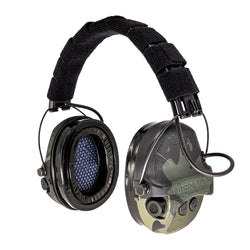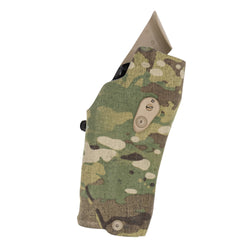Today, we’re looking at two heavy hitters in the subcompact red dot optic world: the CHPWS EDC Enclosed and the Holosun EPS Carry. Both are designed for guns like the SIG P365, the S&W Shield Plus, the Springfield Armory Hellcat, and other similarly sized firearms. What sets them apart from the competition is their enclosed emitter design that squeezes onto these subcompact firearms.
Red dots on handguns are nothing new, but they are changing. Ever since Aimpoint introduced the ACRO, there has been a slow rollout of enclosed emitters. Enclosed emitters offer a higher level of reliability simply by putting a cage around them.

With your standard red dot, rain, snow, dirt, and debris can get between the emitter and the lens. This shuts your red dot off or, at the very least, messes up the reticle’s shape and design. An enclosed emitter doesn’t suffer from that issue.
If you’re shopping and looking for the most reliable red dot for your micro-sized gun, you’ll likely end up looking at the EDC Enclosed or the EPS Carry.
What They Have In Common
These two red dots have a lot in common. Their goal is to provide ultra-reliable red dot performance on the cutting edge of modern red dot technology, while being small and lightweight.
Both offer a nice, long battery life. Each optic gets 50,000 hours out of a 1620 battery. We also get shake-awake technology, which conserves power by putting the optic to sleep when motionless and waking it up when moved.

Battery changes are easy thanks to side-mounted compartments, so there’s no need to remove the optic. Both use similar footprints, allowing direct slide mounting without an adapter plate.
They’re similar enough that the comparison might seem dry, but a few small differences do set them apart.
EDC Enclosed vs. EPS Carry: Dimensional Differences
The size differences between the EDC Enclosed and the EPS Carry are minor; you could argue they aren’t all that important. However, I will counter that by saying the little differences are much more significant when it comes to tiny optics.
The most significant dimensional difference is the weight.
- EDC Enclosed: 1.23 oz (with battery)
- EPS Carry: 1.09 oz (with battery)
It’s slightly over a tenth of an ounce, but I think it counts.

Dimensionally, the EDC Enclosed is slightly shorter from front to back but marginally wider and taller.
The Holosun uses the K footprint, which requires an adapter to work with the standard RMSc footprint. The EDC Enclosed uses the proper RMSc footprint. Does that make a difference? Slightly, but it is unlikely to be super noticeable to most users. The K cut eliminates the rear recoil lugs, making it more water-resistant, while the rear recoil lugs of the RMSc cut (used by the EDC Enclosed) provide additional mechanical resistance to shearing forces that could eventually break the screws.

In terms of water resistance:
- EPS Carry: IPX8 (deeper than 1m submersion)
- EDC Enclosed: IPX7 (up to 1m)
Also, the EPS Carry MRS comes with a solar panel for backup in case your battery dies. Not all EPS Carry models have it, but it should be noted. The EDC Enclosed does not offer the same feature.
Reticles
The EDC Enclosed has a single model, and you can choose between a 2.5 MOA dot, a 34 MOA circle, or a combination of the dot and circle.

The EPS Carry has an entire lineup available in dot-only and multi-reticle systems. The dot-only options include 6 and 2 MOA dots in either green or red. The multi-reticle option comes with a 2 MOA dot, a 32 MOA circle, or a combination of the two. The EPS Carry is also available with the MRS (Multi-Reticle System), and it is available in green and red.
Range Time: EDC Enclosed vs. EPS Carry
My SIG P365XL wears an EPS Carry, and my CZ Nocturne P09 C wears the EDC Enclosed. I’ve been fielding the EDC Enclosed a lot lately, but I’ve used the EPS Carry a bit more over time. I took both to the range for some good old-fashioned shooting to get a good baseline of how they work, look, and perform.
I would like to give you a drastic report on their differences and how one appears to be a clear winner — but they both performed exceptionally well. From a clarity perspective, both optics do a fantastic job.

The EDC Enclosed rates higher for me on clarity, thanks to its lighter notch filter. It has a slight blue tint compared to the EPS’s dark purple tint. Both have sharp, crisp reticles that are easy to see. If this were a blind taste test, I couldn’t tell the difference. I think the EDC Enclosed’s 2.5 MOA dot is a little bigger and nicer for handgun use.
The circular reticles lend themselves to larger, easier-to-see dots. They can also benefit shooters with astigmatism. If we popped these on shotguns or as backups on rifles, we’d have another equal advantage with their larger reticles.

The Holosun EPS Carry has two additional brightness settings that give you a greater spectrum of brightness. Both are compatible with night vision and bright and dim enough for use in all lighting conditions.
The EDC Enclosed has a larger window than the EPS Carry, which might be easier for newer shooters to use, but it’s not a huge factor.
Price
So far, these two optics are similar. Holosun has a slightly more established reputation than CHWPS for red dots, but CHWPS is known for high-quality products overall. Both are great optics.
The biggest difference? Price.
- EDC Enclosed: $249.99
- EPS Carry (dot only): $329.99
- EPS Carry MRS w/ solar: ~$429.99

There is a hefty price gap between the two. While the EDC Enclosed doesn’t offer a solar fail-safe, it provides multiple reticles for much less money. If price is your deciding factor, you get an excellent optic for $250.
The Enclosed World
You really can’t go wrong with either the EDC Enclosed or the EPS Carry. Both are well-made, reliable, and built specifically for micro-compacts. They keep the elements out, offer crisp reticles, and bring all the benefits of red dot shooting to your everyday carry gun.









